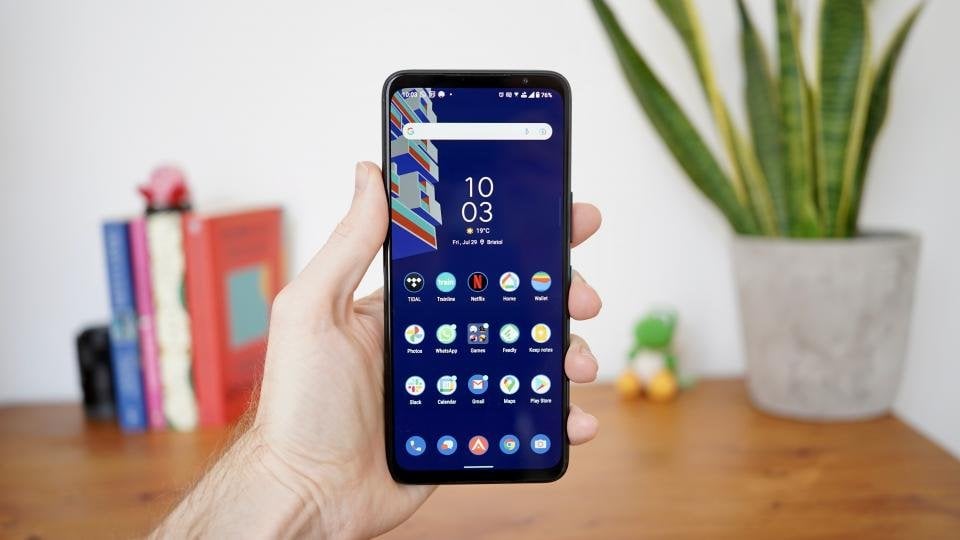
The Asus ROG Phone 6 Pro is a big, powerful gaming phone that shows some consideration for daily use
Pros Top-notch performanceExtremely fluid displayImproved cameraCons Not very different from ROG Phone 6, but much more expensiveOnly IPX4-ratedLacks the built-in cooling of rivals
The constant iterative churn of the gaming phone market comes from a simple imperative: to make a smartphone that plays games faster and smoother. On such simple terms, the Asus ROG Phone 6 Pro is the best on the market at what it does.
While it faces hot competition from the likes of the Nubia Redmagic 7S Pro, the ROG Phone 6 Pro is generally a better-rounded phone that’s more pleasant to use on day-to-day basis. You’ll have to stump up a fair amount of cash for the privilege, however, and it’s not totally without its flaws.
Asus ROG Phone 6 Pro review: What you need to know
As with previous phones in the range, the Asus ROG Phone 6 Pro goes big on the core components. The headline specs are a cutting-edge Snapdragon 8 Plus Gen 1 chip and a large 6.8in OLED display with a rapid 165Hz maximum refresh rate.
It also squeezes in a very large 6,000mAh battery – or rather, two 3,000mAh batteries, which can be charged by either USB-C port: there’s a second one on the left edge, which is better suited to charging while gaming.
The latter also facilitates a bundled-in AeroActive Cooler 6 fan, which adds four physical shoulder buttons into the mix. The phone itself gives you two touch-sensitive “Air Triggers”, which enhance certain competitive games immeasurably.
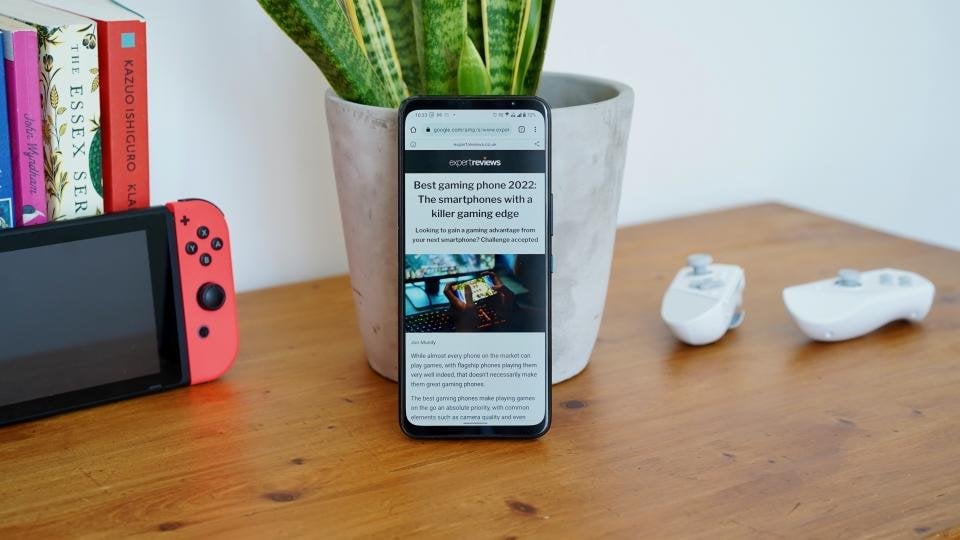
It’s worth pointing out that the Asus ROG Phone 6 Pro and ROG Phone 6 are essentially the same phones, with the Pro model merely adding an extra 2GB of RAM (18GB vs 16GB) and a tiny “ROG Vision” colour PMOLED display on the back.
Asus ROG Phone 6 Pro review: Price and competition
We’ve just mentioned that the Asus ROG Phone 6 Pro and the Asus ROG Phone 6 are practically identical. This makes the £200 price difference somewhat eyebrow-raising.
The Asus ROG Phone 6 Pro costs a steep £1,100, while the Asus ROG Phone 6 costs a still pretty sizeable £900.
In either case, this makes the ROG Phone 6 considerably more expensive than the £669 Nubia Red Magic 7S Pro. This is a gaming-focused phone that also gives you a similar combination of a Snapdragon 8 Plus Gen 1 chip and physical gaming controls, but also pairs those with an integrated cooling fan.

REDMAGIC 7 165Hz Gaming Phone, 5G Android Smartphone, 12GB RAM+128GB ROM, Snapdragon 8 Gen 1, 6.8″ AMOLED FHD Screen, 4500mAh, 64MP Camera, Dual-Sim, NFC, Unlocked Mobile Phone Black (No UK Charger)
£659.00 Buy now
Asus ROG Phone 6 Pro review: Design and key features
Asus hasn’t changed things too much on the design front. This is still every inch the gamer-focused smartphone it intends to be, which means it’s far from subtle.
First things first, it’s downright huge. At 173 x 77 x 10.3mm and with a weight of 239g, it’s not the kind of phone that’s going to disappear into your pocket. It’s not going to melt into the background when it’s outside your pocket, either. The Pro only comes in the one colour: a shiny “Storm White” with icy blue accents, including a completely blue nano-SIM tray and power button.
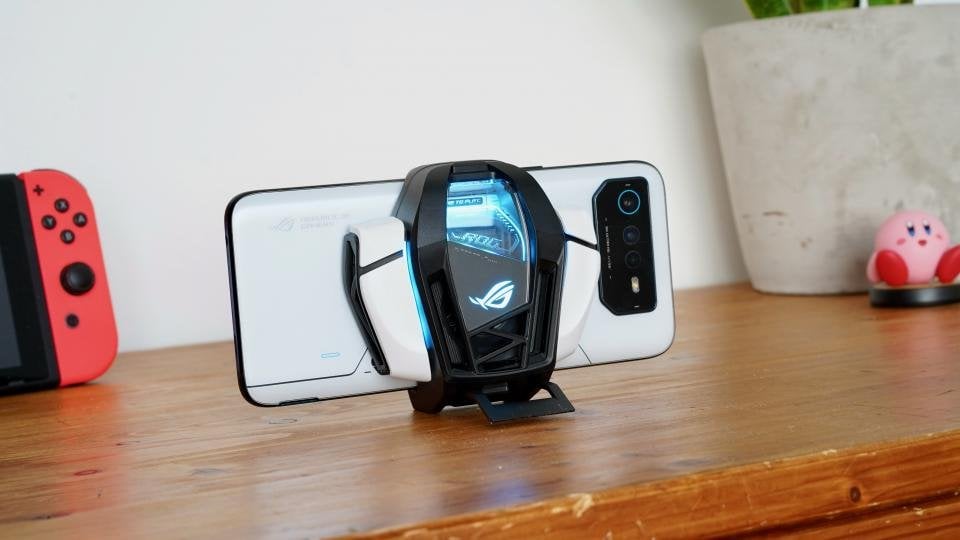
There are splashes of text and futuristic decals dotted all around the frosted glass rear, and the camera module is sharp and angular, too. There’s also a light-up “Dare to Play” slogan, as well as a small ROG Vision PMOLED display that outputs a range of contextual animations. As with the ROG Phone 5s Pro before it, this latter element serves little practical purpose beyond indicating incoming calls or ongoing charging.
Around the front, Asus has admirably stuck to its gaming brief, keeping the selfie camera away from the screen. This is achieved thanks to bulky top and bottom bezels, which also enable a meaty pair of front-firing speakers.
There are a total of two USB-C ports, one on the bottom edge and one on the left-hand edge, the latter of which makes landscape charging easier and also powers the bundled-in AeroActive Cooler 6 fan. All in all it’s a solid, reasonably premium-feeling phone, though that sense of quality is somewhat undermined by a lowly IPX4 rating.
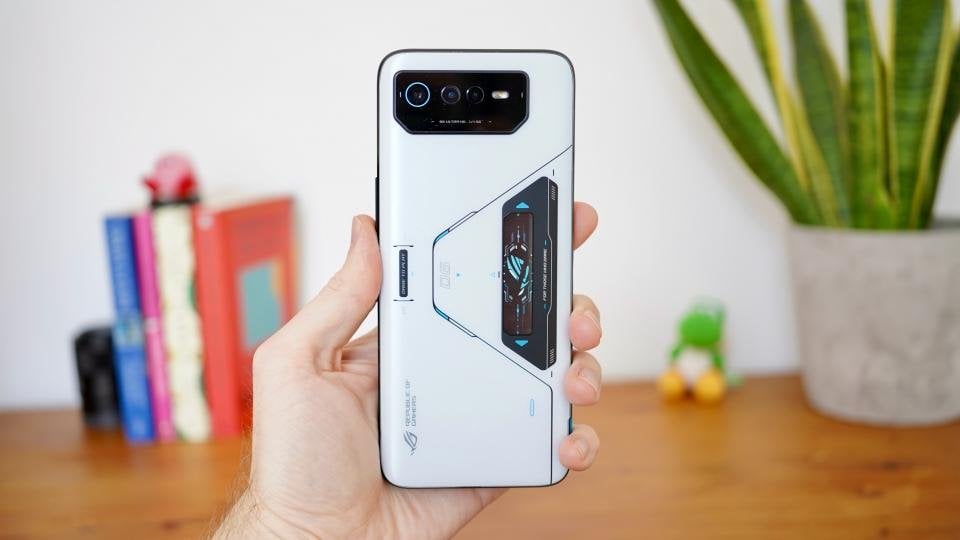
One other feature that’s worth mentioning, especially in relation to other gaming phones, is Asus’s Zen UI. Sat atop Android 12, it’s far lighter and less obnoxious than the Nubia equivalent, and a good deal less buggy to boot. It’s actually usable on a day-to-day basis, with gaming features sitting modestly alongside more general apps and menu elements.
Asus ROG Phone 6 Pro review: Display
As with previous models, both the Asus ROG Phone 6 Pro and ROG Phone 6 come with a 6.78in Samsung AMOLED HDR10+ display, which outputs an FHD+ (2,448 x 1,080) resolution.
This time around, however, the maximum refresh rate has been elevated from 144Hz to 165Hz. There’s no denying that the ROG Phone 6 Pro feels super silky in general navigation when you crank that dial all the way up, but a more consequential upgrade for gamers is a doubling of the touch sampling rate from 360Hz in the ROG Phone 5 to 720Hz.

Asus is claiming that this display can hit a sustained brightness of 800cd/m², with a peak brightness of 1,200cd/m². In my testing, with the auto brightness setting switched off, it hit a maximum measured luminance of 534.8cd/m². That’s quite a bit brighter than the Asus ROG Phone 5s Pro managed last year.
Colour accuracy is also reasonably strong, with a recorded sRGB gamut coverage of 93.4% and a gamut volume of 93.7% in the preferred Normal colour mode, and a solid average Delta E score of 1.3.
Asus ROG Phone 6 Pro review: Gaming, performance and battery life
Performance is king in the world of gaming phones, and the ROG Phone 6 Pro is somewhere near the top of the pile. It’s equipped with the latest Snapdragon 8 Plus Gen 1, which is as fast as they come as far as Android is concerned.
The Pro model comes with a frankly ludicrous 18GB of LPDDR5 RAM, while the ROG Phone 6 comes with an only marginally less ludicrous 16GB. There’s headroom, and then there’s not even being able to see the ceiling.
Benchmark scores confirm what you might expect, that this is among the fastest phones on the market. An average Geekbench 5 multicore score of 4,286 far outstrips the ROG Phone 5s, and closes that formerly cavernous gap to the iPhone 13 Pro Max. It was even more impressive in our GFXBench GPU tests, where it beats anything that isn’t powered by the same chip.
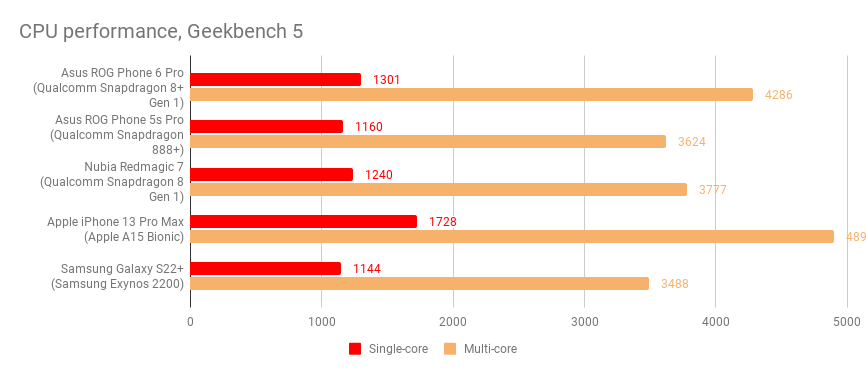
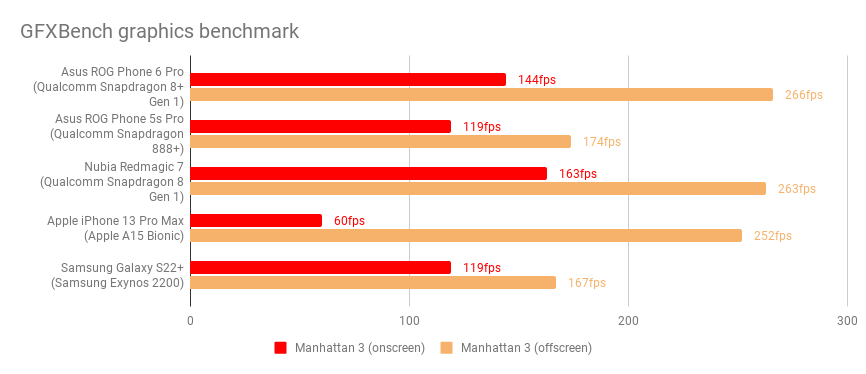
Gaming performance is unimpeachable. With the gaming-focused X Mode active, I was able to run shooters such as Call of Duty Mobile and graphically rich games such as Genshin Impact on maxed-out settings with barely a dropped frame.
Of course, you’ll get similar performance from the Nubia Red Magic 7S Pro, which packs similar specs and costs less. One area where that phone does better out of the box is when under sustained gaming load, where the native cooling fan keeps the performance higher for longer. Asus claims to have made major improvements with its GameCool 6 cooling system, but it still scored lower than its rival in extended GPU benchmarks.
Asus has opted to bundle the AeroActive Cooler 6 fan to achieve the same sort of performance in extended sessions, as well as to provide four additional physical buttons for game input, plus a kickstand for media playback. It undoubtedly makes the ROG Phone 6 a better gaming device, but I’m not sure how practical it will be lugging this peripheral around without you all day.
Even without the AeroActive Cooler 6 attached, Asus provides its Airtrigger 6 shoulder buttons on the right-hand edge. These transform any competitive FPS or MOBA that permit you to remap your controls, allowing you to attribute key actions to physical inputs.
Asus has kept its eye on the gaming prize with its battery offering, too. The ROG Phone 6 Pro comes with two 3,000mAh cells for a combined 6,000mAh battery, just like its predecessors. This is one of the biggest advantages over the aforementioned Nubia Red Magic 7S Pro, which comes with a smaller 5,000mAh cell.
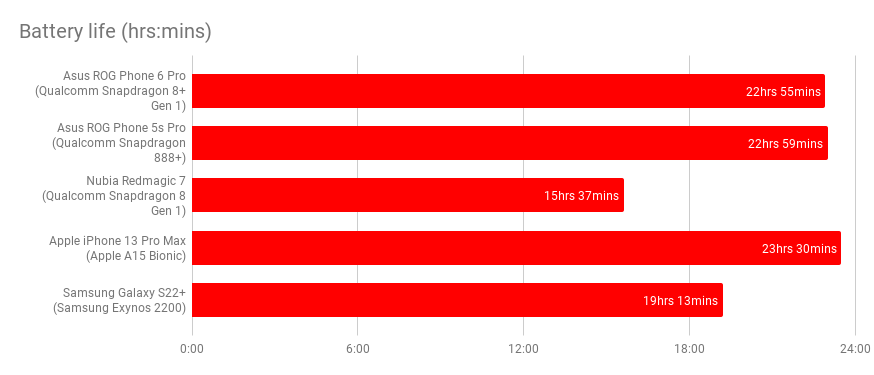
In our regular looping video test, the ROG Phone 6 lasted 19hrs 12mins with the new 165Hz display maxed out. However, with the default Auto refresh rate active, it scored a more comfortable 22hrs 55mins, which is competitive with both last year’s batch of gaming phones and this year’s flagship phones.
Asus supplies a 65W charger in the box, which gets you from empty to 86% in a more than respectable 30 minutes. The manufacturer’s claim that it will get you to 100% in 42 minutes proved pretty much on the money, too.
Asus ROG Phone 6 Pro review: Cameras
We never expect great things from a gaming phone’s camera system. While the Asus ROG Phone 6 Pro’s camera can by no means be described as great, however, it does mark a notable improvement over the ROG Phone 5s Pro.

In fact, it could well have the best camera on any gaming phone to date. That’s entirely down to the switch to a 50MP Sony IMX766 main sensor, which we’ve recently seen performing well in the OnePlus Nord 2T, the Xiaomi 12 and most recently the Asus Zenfone 9.
Shots taken with the Asus ROG Phone 6 Pro don’t rival those three phones, probably thanks to the lack of OIS. But it can still capture bright, crisp, well-exposed shots. Even night shots aren’t a complete write-off, despite the lack of stabilisation.

The 13MP ultrawide and 5MP macro cameras represent a major drop off in detail and exposure, and I’d rather see the latter dropped entirely (see the Asus Zenfone 9) and more attention paid to the two cameras that actually count. But as far as gaming phone cameras go, this setup isn’t half bad.
Asus ROG Phone 6 Pro review: Verdict
The Asus ROG Phone 6 is another excellent option for that small but dedicated niche of hardcore smartphone gamers. It’s as powerful as they come, the physical controls prove transformational to the gaming experience, and the bundled AeroActive Cooler 6 bolsters gaming performance further.
It still represents a compromise in terms of day-to-day practicality, chiefly thanks to a chunky and gaudy design. But the provision of a camera that’s actually capable of taking respectable snaps, in conjunction with a reasonably clean UI, mark a welcome nod to mainstream considerations.

